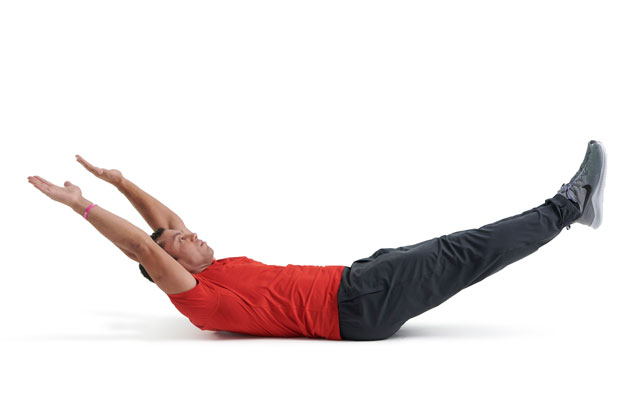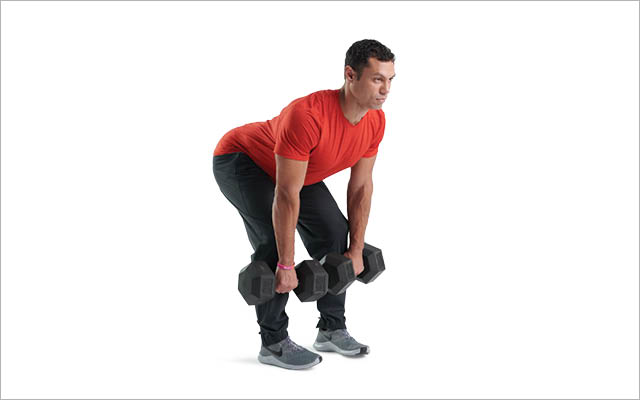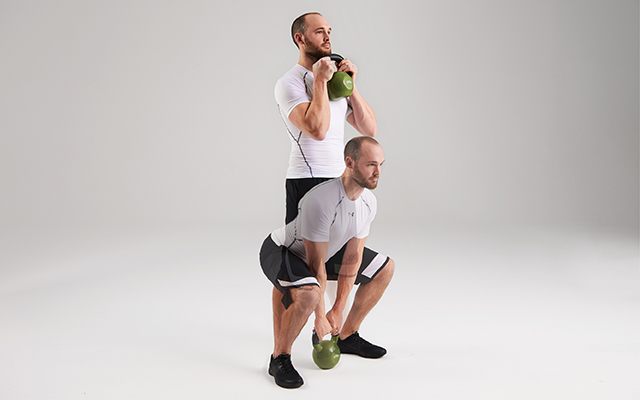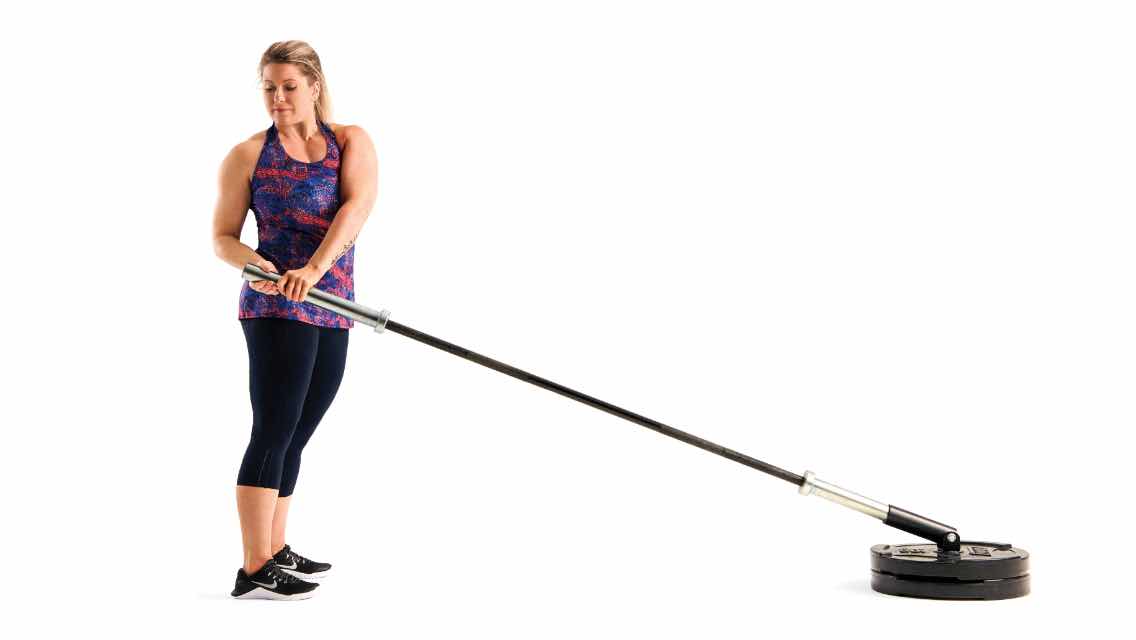This month we’re applying laserlike focus to a single goal: building muscle mass. This means we’ll dial down the overall intensity and cardio efforts as lifting volume increases. Think of the next four weeks as laying the bedrock for better fitness and overall health, giving you the strength to ramp other activities up again next month.
The big difference you’ll notice is that instead of three strength-training workouts per week, you’ll do four. And instead of working the entire body each time, you’ll work the upper body on two days and the lower body on two days.
This allows you to perform a higher volume of work while giving each muscle group more recovery time between sessions. This, in turn, offers greater flexibility in scheduling your lifts: You can strength-train two days — and even up to four days — in a row.
Because the focus here is on strength training, the program calls for just one medium-effort, steady-state cardio workout per week. Perform a cardio activity you enjoy — such as jogging, rowing, swimming, or cycling — for 20 to 30 minutes. You can do this workout on the same day as your strength training or on a different day.
Another option that’s encouraged but not required: On days when you’re not doing cardio, take a 20- to 60-minute walk, ideally in nature, and with other people.
You can also take a walk up to seven days a week, before or after your workout, or any time it’s convenient.
Don’t think of these walks as formal exercise. They’re just head-clearing, meditative strolls. Fit them in when you can, and don’t stress out when you can’t.
Let’s get started.
Month 4 Turn Up the Volume
This month you’ll alternate between four strength workouts. Exercises marked 1A and 1B, 2A and 2B, and so on are pairs; alternate between sets of each move, resting only as long as necessary between sets, until you’ve completed all assigned sets of each movement. Your workout schedule might look like this:
Sample Schedule
|
Week |
Sun. | Mon. | Tues. | Wed. | Thurs. | Fri. |
Sat. |
|
1 |
Workout A | Workout B, Walk |
Rest | Workout C | Workout D | Cardio |
Walk |
|
2 |
Walk | Workout A | Workout B | Workout C | Walk | Workout D |
Cardio |
|
3 |
Workout A | Workout B | Cardio | Walk | Workout C | Rest |
Workout D, |
|
4 |
Rest | Workout A, Walk |
Workout B | Workout C | Workout D, Walk |
Cardio |
Rest |
Workout A
| Exercise |
| 1a. Parallel-Grip Dumbbell Bench Press (Flat) |
| 1b. Self-Assisted Pull-Up (Overhead Grip) |
| 2a. Overhead Press (Barbell) |
| 2b. TRX Row (Shoulders) |
| 3. Kettlebell Triceps Extension: 4 x 12 |
Workout B
| Exercise |
| 1a. Rear-Foot-Elevated Split Squat |
| 1b. Stability-Ball Leg Curl: 3 x technical failure (see “Sets & Reps” below for instructions |
| 2a. Alternating Stepoffs |
| 2b. Hollow Hold: 3 x 30 seconds |
Workout C
| Exercise |
| 1a. Self-Assisted Pull-Up (Underhand Grip) |
| 1b. Parallel-Grip Dumbbell Bench Press (Incline) |
| 2a. TRX Row (Chest) |
| 2b. Overhead Press (Dumbbells) |
| 3. High-Incline Dumbbell Curl: 4 x 10 |
Workout D
| Exercise |
| 1a. Split Squat |
| 1b. Dumbbell Romanian Deadlift |
| 2a. Barbell Hip Thrust |
| 2b. Hollow Hold 3 x 30 seconds |
Sets & Reps
- This month, except for the moves with sets and reps noted in the workout charts above, you’ll alternate between two major rep schemes: three sets of 10 to 15 reps and four sets of five to eight reps, according to the chart below. You’ll get two shots at each rep scheme on each workout this month, so try to use more weight, or get more reps, the second time you perform a given exercise for a given rep scheme. If a set and rep scheme is noted in the charts above, stick with it all month.
- On the exercise noted with “x technical failure” — the stability-ball leg curl — you’ll perform as many reps as possible using perfect form. Terminate the set the moment you deviate from perfect form, and note in your workout journal how many perfect reps you did.
|
Week |
Workout A | Workout B | Workout C |
Workout D |
|
1 |
3 x 10-15 | 4 x 5-8 | 4 x 5-8 |
3 x 10-15 |
|
2 |
4 x 5-8 | 3 x 10-15 | 3 x 10-15 |
4 x 5-8 |
|
3 |
3 x 10-15 | 4 x 5-8 | 4 x 5-8 |
3 x 10-15 |
|
4 |
4 x 5-8 | 3 x 10-15 | 3 x 10-15 |
4 x 5-8 |
Exercises
Self-Assisted Pull-Up
- Stand on a box or bench beneath a pull-up station, so that when you stand on your tip-toes and grasp the bar, your arms are bent and your chin is over the bar.
- Assume an overhand grip — palms facing forward — on the bar.
- Lighten the support from your feet as much as you can, or jump up to lift your feet off the floor entirely.
- Hold the top position for a one-count, then slowly lower yourself, bending your legs until your arms extend fully. Use only as much leg support as needed.
- Reverse the movement to bend your arms and lift your chin over the bar. Use support from your legs only as needed, by staying light on your toes.
- Alternate between performing these with an overhand grip (pictured) in Workout A and an underhand grip in Workout C.
Make It Harder: Do the movement without assistance.
Kettlebell Triceps Extension
- Grasping a kettlebell with the thumb sides of your hands near the weighted ball, lie back on an exercise mat.
- Press the kettlebell over your chest.
- Keeping your elbows stationary, slowly bend your arms, lowering the bell until it grazes the floor behind your head.
- Reverse the movement, keeping your elbows still, and repeat for reps.
Overhead Press
- Stand upright, holding a barbell at shoulder height.
- Keeping your torso vertical, exhale and press the weight to arm’s length overhead.
- Slowly lower the barbell back to the starting position and repeat.
- Alternate between performing these with a barbell (pictured) in Workout A and with two dumbbells, palms facing each other, in Workout C.
Rear-Foot Elevated Split Squat
- Stand about 2 or 3 feet in front of a knee-high box or step.
- Keeping your hips and shoulders square, step your left foot back and place the ball of your foot on the box behind you.
- Keeping your torso upright and your gaze forward, bend both legs, lowering your back knee below the level of your front foot.
- Without pitching your torso forward, reverse the movement and return to the starting position.
- Complete all reps with your right foot forward before switching to your left.
- Alternate between performing these with your rear foot elevated (pictured) in Workout B and with both feet on the floor (in a split-squat position) in Workout D.
Make it Harder: Hold a pair of dumbbells by your sides.
Stability Ball Leg Curl
- Lie on your back with your arms extended along the floor, palms down, heels and lower legs elevated on a medium-size Swiss ball. Keeping your legs straight, lift your hips until your body forms a straight line from your heels to your upper back. This is your starting position.
- Keeping your body extended, slowly bend your knees, pulling your heels toward your butt and lifting your hips as high as possible.
- Squeeze your hamstrings and glutes and slowly reverse the movement, returning to the starting position.
Alternate Step Off
- Stand on a 12- to 18-inch box or bench (the higher the box, the tougher the move).
- Step your left foot off the box behind you.
- Step back onto the box with your left foot.
- Step your right foot off the box behind you.
- Step back onto the box with your left foot.
- Continue stepping off the box alternately with your left and right feet until you’ve completed the full count of reps on each leg.
TRX Row
- Lie back on an exercise bench, feet flat on the floor, holding two medium-heavy dumbbells above your chest, palms turned toward each other.
- Slowly lower the dumbbells until you feel a deep stretch across your chest.
- Exhale forcefully as you press the dumbbells to arm’s length above you.
- Reverse the movement with control and repeat for repetitions.
- Alternate between performing these on a flat bench (pictured) in Workout A and an incline bench in Workout C.
Barbell Hip Thrust
- Sit on the floor and position your upper back against a flat bench.
- Roll a loaded barbell up your legs to the crease of your hips and bend your knees so your feet are flat on the floor. (Place a rolled-up yoga mat between your hips and the bar, if needed for comfort.)
- Hold the bar in place and press your hips into the air until they are fully extended. Your back should rest on the bench.
- Lower your hips and the barbell back down, keeping your upper back pressed against the bench throughout the movement.
- Alternatively, use the hyperextension machine.
Dumbbell Romanian Deadlift
- Stand with feet shoulder width apart and parallel, holding a pair of dumbbells in front of your thighs.
- Draw your shoulder blades back toward the center of your back and hold them there throughout the movement.
- Initiate the movement by hinging your hips back. Keep the weight close to your body as it travels down your legs. Maintain a straight, flat back and keep a soft bend in the knees throughout the movement.
- Once your hips can no longer reach back, squeeze your glutes and thrust your hips forward to return to standing.
- Avoid shrugging the shoulders, especially when returning to standing. Squeeze your glutes at the top of the exercise in each rep.
High-Incline Dumbbell Curl
- Set an adjustable bench to about a 60-degree angle relative to the floor, and sit on the bench holding two medium-weighted dumbbells.
- Lean against the backrest and allow the weights to hang down directly from your shoulders.
- Rotate your wrists so that the thumb sides of your hands face outward.
- Keeping your back flat against the bench and your upper arms vertical, slowly curl the dumbbells toward your shoulders.
- Pause briefly at the top of the movement, return to the starting position, and repeat for reps.
Hollow Hold

- Lie on your back, knees pulled up toward your chest.
- Press your lower back into the floor and lift your head and upper back a few inches, as though you were doing a crunch.
- Extend your arms overhead and your legs outward, feet and hands hovering at about a 45-degree angle with the floor.
- Maintain that position for the duration of the set.
Make It Easier: Bend your knees, keeping toes pointed and heels drawn close to your glutes. Raise your arms and hold them close to your sides, actively reaching fingertips toward your toes and engaging your lats as if pushing down on an imaginary box. Extend your legs straight up and gradually lower them without sacrificing the hollow shape.
Make It Harder: Lower your legs as close to the floor as possible without losing the hollow shape in your midsection. Raise your arms completely overhead without lowering your shoulders to the floor.




This Post Has 0 Comments